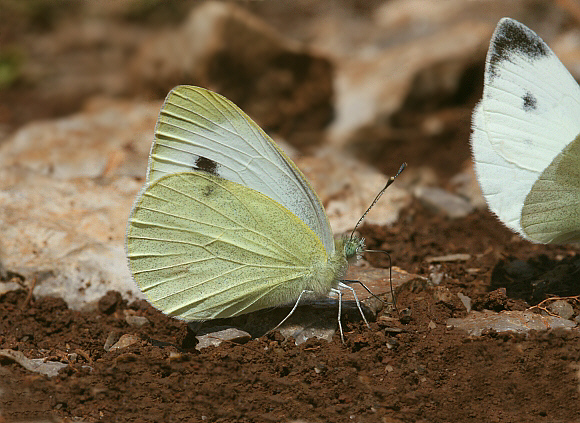 Pieris mannii, males, Velebit mts, Croatia, – Peter Bruce-Jones
Pieris mannii, males, Velebit mts, Croatia, – Peter Bruce-Jones
Introduction
There may be as many as 34 species of Pieris worldwide, although the status of some is uncertain and they may turn out to be merely subspecies. The commonest and most widespread species is rapae, which was originally restricted to Europe and temperate Asia but has been introduced by man ( either deliberately or accidentally ) to North America, Africa, south-east Asia, Australia and New Zealand.
The genus can be divided into 2 groups – the “Large” Whites brassicae, cheiranthi, deota & tadjika; and the smaller species including rapae, mannii, napi and canidia which have more rounded fore-wings. Some taxonomists place the latter group into a distinct genus Artogeia, citing characteristics including chromosome number, ovipositing behaviour and larval morphology.
The Southern Small White is difficult to distinguish from it’s much more common and widespread relative Pieris rapae, but compared to that species the dark apical mark is more squarish, and extends further down the outer margin. In mannii the outer edge of the black spot on the forewing is straight or concave rather than rounded. Another difference is that Pieris mannii has a suffused darkish patch of scales near the apex of the hindwing, which is duller and more heavily dusted in grey scales than in rapae.
On the upper forewings, females of both species have 2 spots arranged like a colon, rather than the single spot as illustrated in the males above. Summer brood adults of both species are more heavily marked than those of the spring generation.
Pieris mannii is found in Morocco, southern & central Spain, southern France, Italy ( incl. Sicily ), Croatia, Albania, Romania, Bulgaria, Greece, Turkey and east to Syria.
Habitats
This species is found in hot, arid, rocky habitats, most commonly at altitudes between sea level and about 1200m, but has been recorded as high as 2000m in the Middle Atlas mountains.
Lifecycle
The Southern Small White produces 2 or 3 broods a year, and can be found almost continuously from March to October; except in the Atlas mountains where it is univoltine, emerging in July.
The eggs are laid singly on leaves of candytuft Iberis sempervirens and I. saxatilis.
Adult behaviour
The butterflies have a strong and direct flight, interrupted by periodic feeding bouts.
Females nectar at a wide variety of flowers including marjoram, thistles and valerian. Males are more often seen drinking at seepages, urine-tainted soil or along the shoreline of rocky streams, where they often congregate in groups of a dozen or more.
